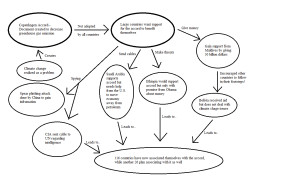2. I mainly focused on the exchanges between the climate change, the cables, and their result on gaining support for the Copenhagen Accord. During the article, it tells how each country wanted the accord to be adopted but it also encourages each nation to focus on ways to reduce the greenhouse gases. This allowed easier access to rapidly growing countries than that was proposed by the United Nations. In the beginning of my diagram I tried to explain how climate change fortified the construction of the Copenhagen Accord. The United States was pushed to find ways to gain the approval of countries that did not support the accord. I broke down ways in which the United States fought to change the attitudes of some of these countries. Some of the thing they used to fortify the countries were spying, cables, money and threats. All the countries in the article had to commit to make some changes to reduce greenhouse gases. Many of the countries have agreed to make a change, so in the diagram I tied it together by showing how over one hundred and sixteen countries decided to support the accord. There were a lot of countries in the article, but here are a few that I mentioned were United States, Ethiopia, Maldives, and Saudi Arabia. Also I showed how twenty-six countries are going to commit to the accord on a later date. It seemed that the ways in which the United States encouraged support by spying, cables, money and threats have worked.
3. When I finished reading the article, the cable leak made it more difficult for the collective action than it did before. For the collective action to work it needed groups of countries to work together to reduce the discharges of greenhouse gases. In the article it tells how United States got other countries to support the accord. One of the ways was to promise a country financial aid. Some of the countries did the reduction just for the money it was going to receive. If the countries do not get the financial aid that was promised they might stop any effort to reduce the greenhouse gases. Both countries and individual need to reduce the greenhouse gases because these gases could affect our future. We need to realize that the climate change could affect how plant life survives in the future and how each one of us adapts to the changing of climate. Some of the climate changes that we might experience is the hot temperatures and rising of the rivers or streams due to the melting of the snow that we had during the winter months. The United States might be frustrated by the other countries that do not want to help support the accord. I feel we should not threaten countries to help reduce the greenhouse gases. They should want to do this freely to help their people to survive the climate changes. If we have conversation with our neighboring countries about the greenhouse gases and what each one of us can do to reduce it we might be able to have a better future for our children.


Hello Christina, im Garrett and I looked at your diagram and i think you did an excellent job with it. I can tell just by looking at it that you spent a lot of time with it. I agree with you about how the US doesn’t need to threaten, or bribe other countries to join the fight in climate change. What actually should be done is a meeting where these diplomats get together and formulate a tentative plan that can be enacted in all countries. I also agree that climate change is a serious threat to our children, and our grandchildren. This is a problem of such magnitude that a country cannot create a law to address it just in their home country, then force other countries to sign it. Again great job on the diagram, if you feel so inclined check out mine here.
http://sites.psu.edu/geog30/2016/04/06/garrett-webster-climate-change/